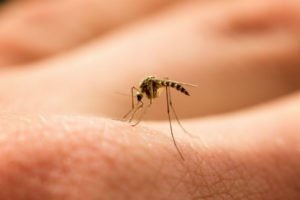Humble TX mosquito control is absolutely necessary for residents in the Greater Houston Area. Terminix ranked Houston as the third most mosquito-infected city in the United States. This means it is critical residents in Houston implement tactics against these blood-sucking pests.
Texan Mosquito Systems can install an effective misting system in your backyard to repel mosquitos and prevent them from thriving. Our professional technicians will walk you through the installation process. We offer various types of systems, such as tankless systems or systems that have barrels. We want homeowners to feel comfortable about choosing a system that fits their needs.

Texan Mosquito Systems can install your mosquito system within a day.
Our technicians do more than just install your misting system. They also educate you on how to use your system, how to maintain it, and how to keep it running for years to come. The installation process of a mosquito system takes about a day, depending on the weather and when we start. On average, the process can range from four to ten hours.
Once your misting system is installed, our technicians will show you the system we installed and how to use it. Before they go, they will schedule monthly visits to your home to refill tanks and maintain the system. If there is ever a point in which you see a nozzle has been damaged, then contact us. We would be happy to perform a repair.
The Mosquito Life Cycle
The mosquito life cycle requires water. Standing water in lakes, ponds, wells, birdbaths, fountains, buckets, tires, and other containers are the perfect places for mosquitos to lay their eggs. The first stage of the mosquito life is an egg. Adult females lay all their eggs on the surface of the water like rafts. The rafts float at the top of the water before they hatch into larvae. Typically, eggs hatch within the 48 hours after being laid.
The second stage of a mosquito life is the larva. Larvae live in the water they are laid in and feed on the microorganisms within the water. They will come up to the surface for air and molt four times. Molting is their process of shedding their skin and becoming larger every time. Once the fourth molt is complete, the larvae will turn into pupae.
The pupa stage is similar to the stage when butterflies perform metamorphosis in their cocoons. Pupae rest during this stage, but they are still active. They can respond to light changes and move to safer areas such as the bottom of the water source. This process usually takes about two days, and the pupae skin will split, and adults will emerge.
A newly emerged adult will rest on its pupa skin at the top of the water. This is to let the water on its wings dry off and allow parts of its body harden. The adult will be unable to mate or feed on blood for another couple of days after it hatches.
The total length of hatching a new mosquito greatly depends on the species and the temperature. Some species have adapted to hatch in a few days while others take months. Plus, temperature and increase or slow down the process.
The Problem with Mosquitos

Mosquito-born illnesses are capable of being severe which is why preventing them is important.
Not all mosquitos drink blood. In fact, male mosquitos in the United States feed on plant nectar while females target animals and humans. Mosquitoes are effective methods of spreading disease, and we see that proven every year. These blood-sucking pests are capable of spreading several types of disease such as Sika virus, West Nile virus, Chikungunya virus, dengue, and malaria. These diseases are capable of being deadly if found in immune-deficient individuals.
Mosquitos spread disease, but they also leave behind red, itchy bumps after biting you. The bump will most likely be itchy and puffy. You may experience hives or even blisters. Typically, the symptoms of bites go away on their own, but some cases may be more extreme. In that case, prescription ointments may be necessary.
Control Mosquitos in Your Backyard
There are many steps you can take to reduce the presence of mosquitos in your yard. You can follow the steps below to improve your backyard environment and create a happier environment for your family.
Removing Standing Water
Since water is an essential part of a mosquito’s life cycle, it is best to remove any places where water is left stagnant. Mosquitos can lay their eggs in just a half inches of water. This means you should remove water from buckets, tires, gutters, and other areas it collects. If you have a birdbath, then replace the water inside of it every week. This will help you interrupt any mosquito life cycle.
Treat Water You Cannot Remove
When it comes to sources of water, you cannot remove (i.e., ponds, fountains, and pools), treat them. There are a plethora of treatment options you can choose to treat these water sources. When it comes to pools, ensure your pool is properly regulated, and the chlorine levels are at the appropriate level.

Treat water in your yard that cannot be removed.
For other water types, it is recommended to use Mosquito Dunks. This product is made up of natural materials and does not harm other organic life. Throw a dunk into the water where it will resolve. It releases a bacteria that eliminate mosquito eggs and pupae from the water. You can use this in your coy pond or birdbath and not worry about it hurting the animals.
Maintain Your Backyard Growth
Tall grass and weeds are great places for mosquitoes to rest their wings. Once you eliminate these areas, they will avoid the area because they have no place to rest. Mosquitoes rest during the day in these areas, so remote their resting place by cutting the grass to at least five inches.
Humble TX Mosquito Control
Texan Mosquito Systems can provide you with an effective misting system for your backyard. Contact our team today by calling (713) 766-1090. Our Houston location can provide you the mosquito control system you need for your backyard. That way, you can start enjoying your backyard and stop needing a Humble TX mosquito control system.
Fun Facts about Humble
- Humble was settled in the early 1800s by Joseph Dunman.
- In 1904, the first railroad entered the city, and Humble was incorporated in 1933.
- Humble has attractions such as the Botanical Gardens, Humble Historical Museum, and Sheldon Lake State Park.
- Locate more facts about Humble here.
